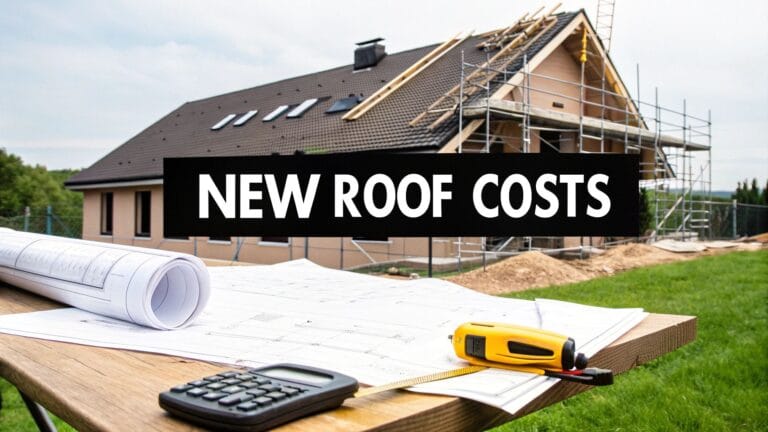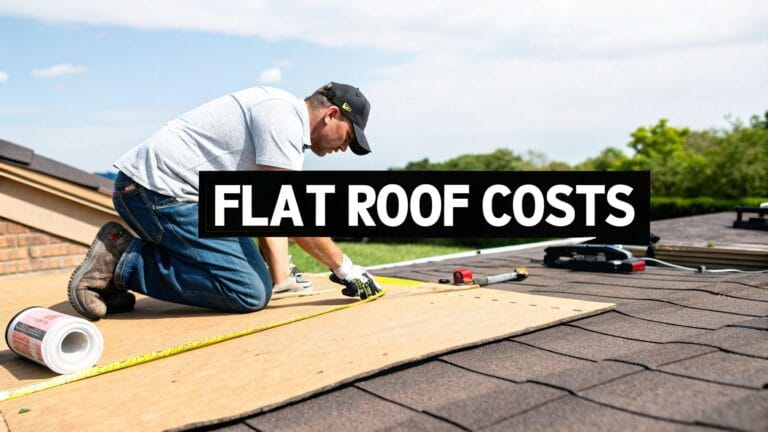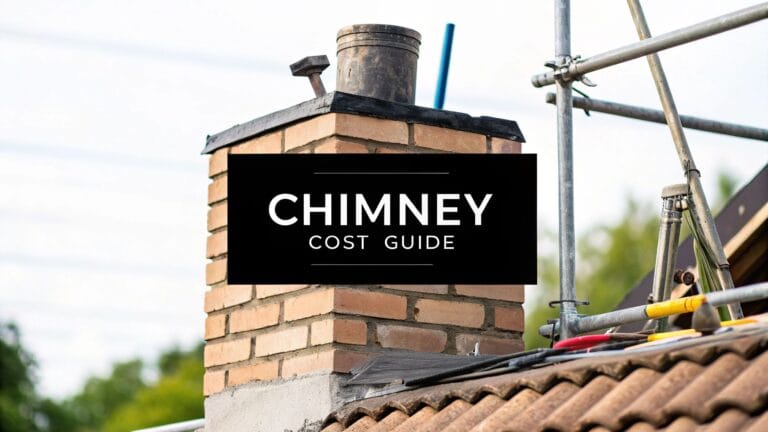
How Long Do Roofs Last? A Practical Guide for UK Homeowners
Wondering how long do roofs last? Discover important factors influencing roof lifespan and practical insights to protect your UK home. Learn more today!
How long your roof will last in the UK really comes down to what it’s made of, but a well-cared-for roof can happily protect your home for decades. While some modern flat roofs might need replacing in 10-20 years, traditional materials like natural slate can incredibly last for over a century. This makes your choice of material a critical long-term decision for your home.
Your Roof's Lifespan: What to Expect in the UK
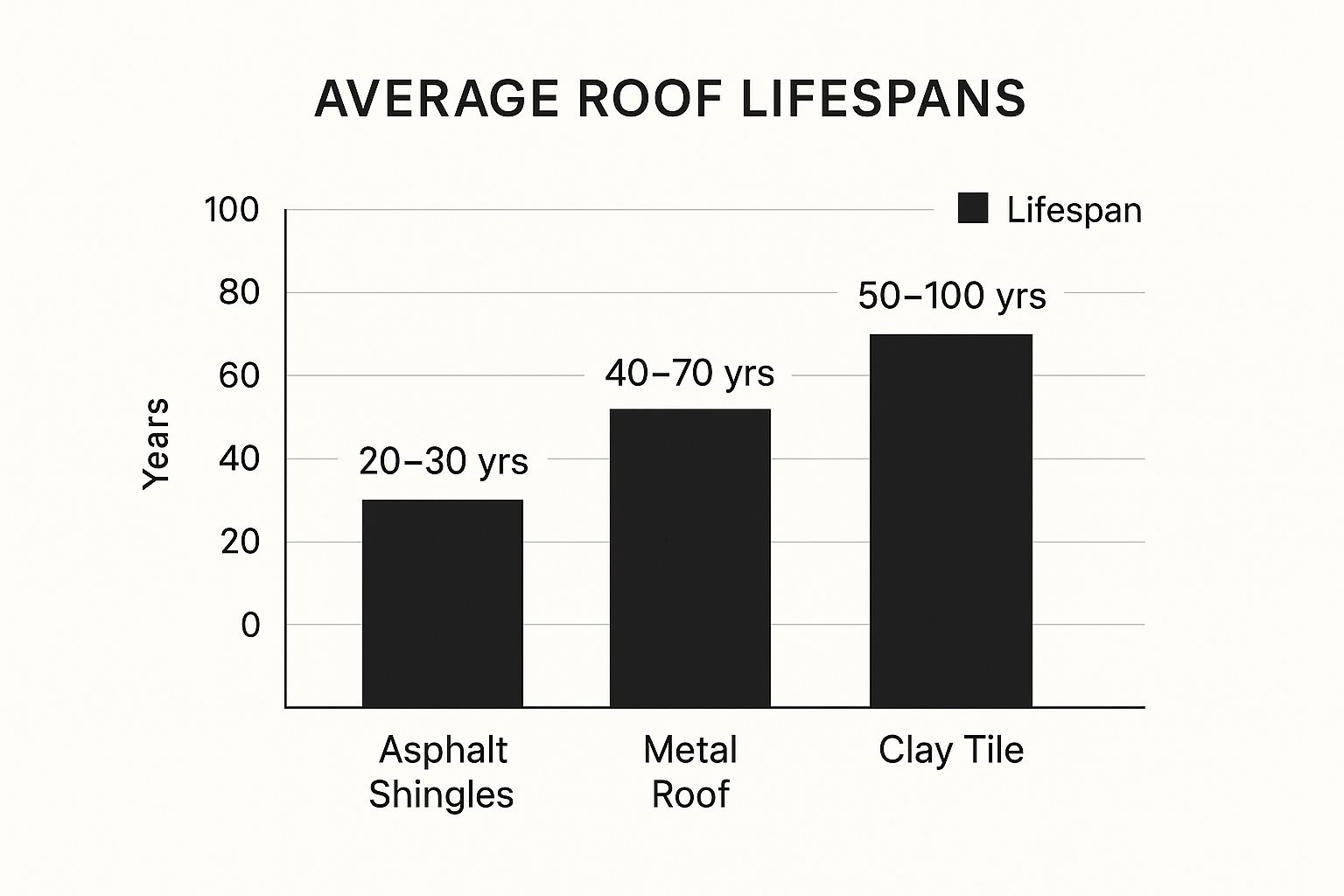
Think of your roof a bit like you would a car. A well-built, premium model is designed to go the distance, but it won’t get there without regular servicing and proper care. It’s the same with roofing; high-quality materials have a fantastic potential lifespan, but whether they actually reach it depends entirely on the quality of the installation and how well they’re maintained over the years.
Here in the UK, we have a unique climate—often damp, windy, and unpredictable. While roofing materials have certainly evolved, many traditional options are still incredibly popular precisely because they’ve proven they can stand up to our weather. For example, the Welsh slate on a Victorian terrace in Cardiff has likely endured over a century of rain, while the felt roof on a 1980s garage extension in Manchester might be showing its age after just 15 years. Knowing the typical lifespan for each type is the first, most crucial step in figuring out the health of your current roof and planning for the future.
To give you a clearer picture, here’s a quick comparison of the lifespan you can expect from the most common roofing materials you'll see on UK homes.
UK Roof Material Lifespan At a Glance
| Roofing Material | Typical Lifespan (Years) | Key Characteristics |
|---|---|---|
| Natural Slate | 75 – 150+ | Extremely durable, classic appearance, fire-resistant, but heavy and requires skilled installation. |
| Clay Tiles | 50 – 100 | Long-lasting, excellent colour retention, resistant to rot and insects. Can be brittle. |
| Concrete Tiles | 40 – 60 | Cost-effective alternative to clay, versatile in style and colour, but can fade over time. |
| GRP Fibreglass | 25 – 40 | Seamless and waterproof, ideal for flat roofs. Strong and low-maintenance. |
| EPDM Rubber | 20 – 30 | A flexible and durable single-ply membrane, great for flat roofs. Resistant to extreme temperatures. |
| Felt (Bitumen) | 10 – 20 | The traditional, budget-friendly option for flat roofs. Prone to weather damage over time. |
As you can see, the difference between materials is significant. A well-laid slate roof could easily see out your lifetime and that of the next generation, whereas a felt flat roof is a shorter-term solution.
Average Lifespan by Material
The material on top of your property is, without a doubt, the biggest factor in its longevity. Natural slate and clay tiles, which are absolute staples of British architecture, are famous for their staying power. It's not uncommon for a natural slate roof on a period property to last 75 to 150 years, and clay tiles regularly last between 50 and 100 years.
On the other end of the spectrum, more modern or budget-conscious choices offer shorter, though still very reliable, service lives. Concrete tiles, a common sight across post-war housing estates, will typically give you 40 to 60 years of protection. Flat roofs, which you’ll often find on garages and extensions, vary quite a bit. Old-school felt might only last 10-20 years, but modern systems like EPDM rubber (20-30 years) and GRP fibreglass (25-40 years) offer much better performance. You can find more detailed insights on what affects these lifespans from established UK roofing specialists.
Your roof is a complete system. While the tiles or slates are the main shield, their real lifespan also hinges on the quality of the timber structure beneath, the lead flashing, and the ventilation.
If you neglect these other crucial parts, even the toughest materials can fail long before their time. Here at Evershield Roofing, our professional inspections give you a complete picture, making sure every part of your roof is working together to keep your home safe and sound for years to come.
A Practical Look at UK Roofing Materials

Those lifespan numbers are a great start, but they don't tell the whole story. To really understand what’s protecting your home, you need to get to know the materials themselves. Let's look past the averages and get a real-world feel for the common roofing materials you see all over the UK.
Every material has its own character—its own set of strengths and weaknesses, especially when pitted against our notoriously damp and unpredictable British weather. Think of a slate roof like a stone monument; it's built from the earth to endure for centuries, a natural resilience that modern materials often try to copy. By appreciating these differences, you can get a much clearer picture of what's on your own roof and what it will need over the years.
Traditional Pitched Roofing Materials
When you imagine a classic British street, chances are you’re picturing homes with pitched roofs covered in slate or clay tiles. These materials have shaped our towns and villages for generations, and for very good reasons.
Natural Slate: This is the undisputed champion of longevity. A well-laid Welsh slate roof can easily last over 100 years, and it’s not uncommon to see them still going strong at 150 years. It’s a dense, natural stone that’s almost completely non-porous. This means it shrugs off water effortlessly and stands up brilliantly to frost. A practical example is the original slate on a Victorian terrace; the slates themselves are often fine, but the iron nails fixing them eventually rust through after 80-100 years, causing the slates to slip.
Clay Tiles: Known for their warmer, often reddish-brown appearance, clay tiles are another long-standing favourite in the UK. They have a fantastic lifespan, typically between 50 and 100 years, and are incredibly durable, holding their colour beautifully over time. Their main vulnerability is brittleness. A hard impact from a falling branch or a severe frost cycle can crack them if moisture finds its way into any tiny imperfections.
Concrete Tiles: A more modern and budget-friendly alternative, concrete tiles gained popularity in the post-war building boom. They are manufactured to look like slate or clay but have a shorter working life, usually around 40 to 60 years. The main issue is that their protective top layer wears down over time, leaving the tile more porous. This allows it to absorb moisture, which not only encourages moss growth but can also cause the tile to crumble during freeze-thaw cycles.
Think of a concrete tile like a painted garden wall. When it's new, the paint creates a tough, waterproof barrier. But after years of sun and rain, the paint wears thin, and the brickwork beneath starts to soak up water, which eventually leads to damage.
Modern Flat Roofing Systems
Flat roofs are a practical choice for extensions, garages, and modern commercial buildings. The technology in this area has come on leaps and bounds over the past few decades.
GRP Fibreglass: Glass Reinforced Plastic (GRP) is a tough, seamless system that starts as a liquid before hardening into a single, solid waterproof layer. It's incredibly durable and can handle foot traffic, making it a great option for balconies or terraces. You can expect a GRP roof to last 25-40 years.
EPDM Rubber: Ethylene Propylene Diene Monomer (EPDM) is essentially a large, custom-fit rubber sheet that's bonded directly onto the roof deck. Its fantastic flexibility allows it to expand and contract with temperature changes without splitting or cracking. A properly installed EPDM roof will typically last 20-30 years, often longer.
Whether your roof is topped with traditional slate passed down through generations or a modern rubber membrane, understanding its unique properties is the first step to looking after it properly. At Evershield Roofing, our team has years of hands-on experience with every material common to UK homes. We can give you a straight-talking assessment of your roof's condition, helping you understand exactly how long it should last and what it needs to reach its full potential.
Factors That Shorten or Extend Your Roof's Life
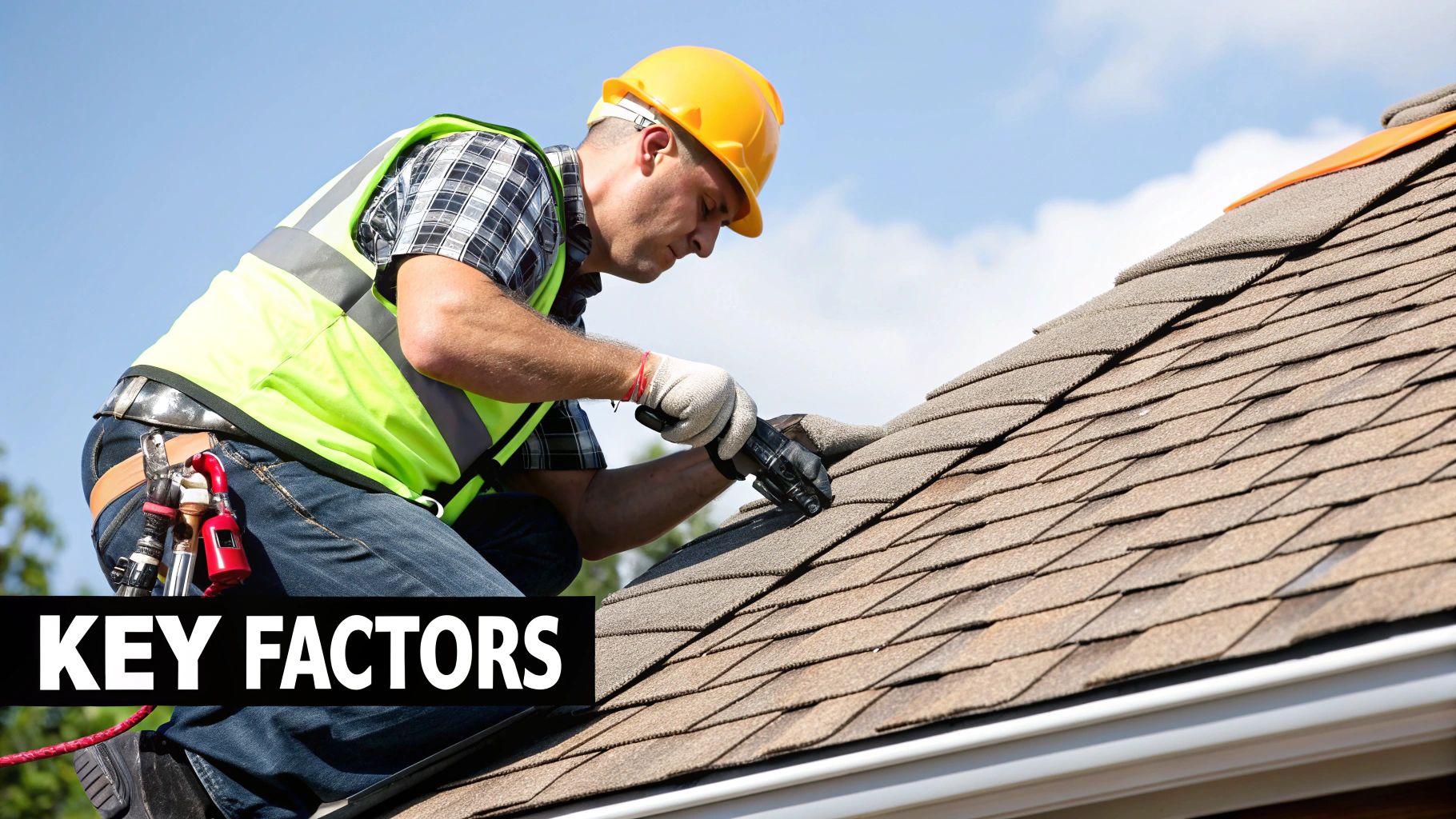
Choosing a premium material like natural slate is a fantastic start, but it’s no guarantee of a century of watertight protection. The material itself is just one piece of a much larger puzzle. In reality, a handful of other factors can add or subtract decades from a roof’s expected lifespan.
Think of it like buying a top-of-the-range car. The engine and build quality are superb, but if it’s serviced poorly and driven recklessly, it’s not going to last. A roof is no different. How it’s installed, the weather it faces, and the care it receives are just as vital as the tiles it’s made from.
The Critical Role of Installation Quality
After the material itself, the quality of the initial installation is probably the single most important factor. A roof laid by a skilled professional is a seamless system where every component works together perfectly. On the flip side, even the most expensive slates will fail if the workmanship is poor.
A botched installation can cripple a roof from day one. Some of the most common mistakes we see at Evershield Roofing include:
- Improper Nailing: If nails are under-driven, over-driven, or fixed in the wrong spot, tiles and slates become vulnerable to being lifted by strong winds.
- Incorrect Flashing: Poorly installed lead or GRP flashing around chimneys, valleys, and vents is one of the biggest culprits behind leaks.
- Inadequate Ventilation: A badly ventilated loft traps heat and moisture. This can slowly rot the roof’s timber structure and even cook the tiles from the inside out.
The Unforgiving UK Climate
Let’s be honest, the British weather is relentless, and your roof is on the front line 24/7. The specific conditions your home faces have a massive impact on its longevity. A home on an exposed coastline in Cornwall, for example, is going to take a much bigger beating from driving rain and salty winds than one tucked away in a sheltered part of Surrey.
The constant cycle of rain, wind, and frost is a serious test of your roof's endurance. Over time, prolonged dampness accelerates wear on all materials and encourages the growth of moss, which traps even more moisture and can lift tiles.
The Power of Regular Maintenance
Finally, the best tool you have to maximise your roof’s life is simple, proactive maintenance. A neglected roof will always fail sooner than one that’s looked after. Regular checks can catch small issues long before they snowball into expensive, major repairs.
Ignoring your roof can also lead to more serious headaches than just wear and tear. After a severe weather event, for instance, understanding how to handle storm damage insurance claims becomes crucial.
You can learn more about how to look after your property with our detailed roofing maintenance tips. At Evershield Roofing, our experts can help you put a simple maintenance plan in place, ensuring your roof delivers the full, long life it was designed for.
Warning Signs Your Roof Needs Attention
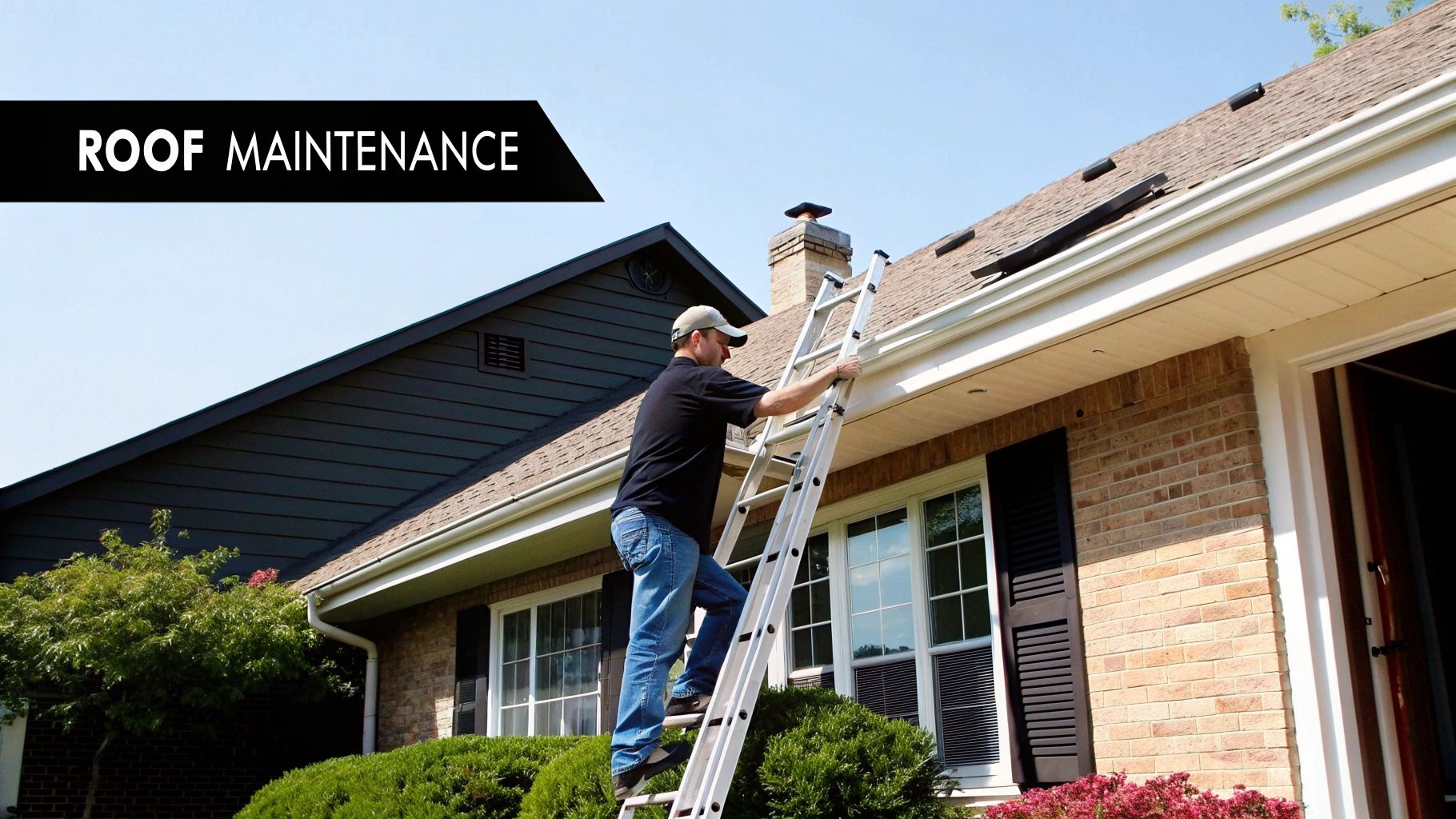
Knowing the average lifespan of your roof is one thing, but roofs rarely fail all at once. Instead, they send out signals—some subtle, others glaringly obvious—that they're approaching the end of the road. Learning to spot these clues can save you a world of stress and expense down the line, letting you plan for a replacement rather than react to a crisis.
It’s a bit like the warning lights on your car’s dashboard. You wouldn't just ignore the oil light and wait for the engine to seize, would you? The same logic applies to your home’s most important shield. Catching problems early puts you back in control before a small issue becomes a full-blown emergency.
External Clues You Can Spot From The Ground
You don't need to be a roofer with a ladder to get a good idea of your roof's condition. In fact, a simple walk around your property can tell you a surprising amount.
Keep an eye out for these key indicators:
- Cracked or Missing Tiles: This is the big one. Even a single cracked slate or a missing tile is like leaving a door wide open for rain to seep into the timber structure underneath.
- Granules in Your Gutters: For those with concrete tiles, finding a gritty, sand-like substance in your gutters or at the bottom of downpipes is a bad sign. This is the protective top layer of your tiles washing away, leaving them exposed and vulnerable to frost damage.
- Heavy Moss or Algae Growth: A little bit of green is perfectly normal in the UK, but thick carpets of moss are a real cause for concern. Moss traps moisture like a sponge, keeping the roof surface constantly damp, which speeds up wear and can even push tiles out of alignment.
Don’t underestimate what looks like a small problem. One slipped tile might seem insignificant, but after a long, wet British winter, it can let an astonishing amount of water into your roof space, leading to rot and damp problems inside your home.
Internal Signs Hiding In Your Home
Sometimes, the most urgent warnings aren't on the outside at all—they’re inside your house. These clues often mean a leak is already active, so it’s vital you act quickly.
The first place to look is your loft. On a sunny day, pop your head up there and see if you can spot any chinks of daylight coming through the roof. That’s a dead giveaway you have a hole or a slipped tile. While you're there, look for dark water stains on the timber rafters or insulation that looks damp and squashed; these are classic signs of a slow, persistent leak.
Further inside your home, watch for damp patches or brown stains appearing on ceilings, particularly in the top corners of upstairs rooms. This is often the final alarm bell, signalling that water has made its way past all your roof's defences. For a more thorough breakdown, you can read about the key signs your roof is leaking in our detailed guide.
If you’ve noticed any of these signs, there's no need to panic. The best thing to do is get a professional opinion. Just get in touch with our team here at Evershield Roofing for a no-obligation inspection, and we'll give you an honest assessment of what needs to be done.
How Our Professional Inspections Protect Your Home
Spotting the obvious warning signs of a failing roof is one thing, but a quick look from the ground can only ever tell you part of the story. To really get a grip on its condition and how much life it has left, you need a trained eye to get up close and personal. This is where a professional inspection moves past guesswork and gives you genuine peace of mind.
Think of it this way: a DIY check is like judging a book by its cover. A professional inspection from Evershield Roofing, on the other hand, reads every single page. Our proven process makes sure no detail is overlooked, giving you a complete and honest picture of your roof's health. We’re not just hunting for obvious damage; we’re assessing the entire system to stop future problems in their tracks.
Our Comprehensive Evaluation Process
When you book an inspection with us, our technicians carry out a meticulous, multi-point assessment. We believe in being thorough because it's nearly always the small, hidden issues that snowball into major headaches down the line.
Our evaluation always includes:
- A Detailed Tile-by-Tile Check: We examine the condition of individual slates or tiles, looking for things like cracks, slippage, and the loss of granules that signal they’re nearing the end of their life.
- Flashing and Sealant Inspection: The leadwork and seals around chimneys, vents, and valleys are common weak points. We check them carefully, as this is where water most often finds a way in.
- Structural Assessment: From inside the loft space, we inspect the underlying roof deck and timber rafters for any signs of dampness, rot, or structural weakness.
- Gutter and Drainage Review: We make sure your gutters are clear and working properly. Blockages are a classic culprit for causing water to back up and seep under the eaves.
Using Modern Tools for Safety and Accuracy
For particularly complex or hard-to-reach roofs, we often bring in modern tools to guarantee a safe and complete survey. This approach lets us get a crystal-clear view of every nook and cranny without putting your property—or our team—at risk. For really advanced survey methods, professionals can now use technology like a construction drone inspection.
This technology is a game-changer for identifying subtle problems on large or steeply pitched roofs that are impossible to see clearly from a ladder. It gives us high-resolution images, helping us pinpoint potential issues with incredible precision.
A professional inspection isn't a sales pitch in disguise. It’s a vital health check for the most important shield your home has. Our goal is simple: to give you clear, factual information so you can make confident decisions about your property.
Once we’re done, we’ll give you a comprehensive, easy-to-understand report. It will break down your roof’s current condition, highlight any potential issues we’ve found, and provide clear, honest recommendations. You can find out more about why we champion this proactive approach by reading our guide on the importance of regular roof inspections.
By investing in a professional assessment from Evershield Roofing, you’re taking the single most effective step toward understanding how long your roof will last and how to protect your home for years to come.
Your Roofing Questions Answered
We've explored the lifespan of different roofing materials, but you probably still have a few questions buzzing around. Let's tackle some of the most common queries we get from homeowners across the UK. Think of this as a quick chat with a roofing expert, clearing up those final details so you can feel confident about your property.
Can a Roof Last Longer Than Its 'Best Before' Date?
Definitely. Those lifespan figures – 20 years for felt, 100 for slate – are really just averages, not a hard-and-fast expiry date. A roof can absolutely sail past its expected lifespan, but it won't happen by chance.
It’s a bit like two identical cars. One gets a regular MOT and service, is kept clean, and is driven with care. The other is thrashed about, never washed, and skips every service. You know which one will be on the road longer. Roofs are no different.
So, what gives a roof that extra lease of life?
- A Top-Notch Installation: We can't stress this enough. When a roof is fitted by a skilled team using the right techniques from day one, it has a massive head start.
- Consistent Maintenance: This is where you, the homeowner, can make a huge difference. Simply keeping gutters clear, getting moss professionally removed, and swapping out the odd cracked tile before it becomes a leak can add years, sometimes even decades, to your roof’s life.
- A Friendly Microclimate: A house tucked away in a sheltered location, shielded from the worst of the wind and not stuck under massive, overhanging trees, will always have an easier time and face less stress over the years.
Is Moss on My Roof a Red Flag?
Not necessarily an immediate crisis, but it’s something you should never, ever ignore. A little bit of green on the tiles is pretty normal in our damp British climate. But when it starts to look like a thick, green carpet, you’re inviting problems.
Imagine a heavy, damp sponge sitting on your roof all year. That's what a thick layer of moss does. It holds a huge amount of water right against the surface of your tiles. This constant moisture can speed up the decay of concrete tiles and, in winter, cause serious frost damage when the trapped water freezes and expands, cracking the tile. Heavy growth can even start to lift the edges of tiles, creating a direct path for rainwater to get in.
While a light dusting of moss isn't a five-alarm fire, heavy growth is a clear signal that your roof is holding too much moisture – and moisture is the number one enemy of every roofing material.
A professional clean is the best course of action. It gets rid of the moss without damaging the tiles, allowing your roof to do its job properly and shed water away from your home.
What's the Real Cost of a Roof Replacement in the UK?
This is the big question, isn't it? The most honest answer is: it really does vary. Throwing out a single "average cost" is more confusing than helpful because no two roofs are the same. The final bill is always a mix of several key things.
Here’s what really drives the price:
- Your Choice of Material: As we've seen, the cost spectrum is wide. You could go for a budget-friendly material or invest in a premium, long-life option like Welsh slate. This is the single biggest factor in your final quote.
- The Size of Your House: It's simple maths, really. A bigger roof requires more materials and more man-hours to complete, which naturally pushes the cost up.
- How Easy it is to Access: A simple, two-up-two-down terrace is a world away from a multi-level detached house with tricky roof angles. The complexity, scaffolding requirements, and on-site safety all play a part in the price.
The only way to get a true picture of the investment needed for your property is with a detailed, on-site survey. The team at Evershield Roofing offers no-obligation inspections and provides clear, transparent quotes tailored to your home. Contact us today to book your free survey and understand your options properly.

